
Оперативная память Kingmax KLBC28K-A8HD4 ничем не примечательная, уже устаревшего, хотя все еще массово используемого типа DDR2, не самая быстрая - 533 МГц, да и мизерный объем - 512 Мб один модуль... совсем не актуально. Ее и описывать уже нет смысла, однако на ЭТОМ ПРИМЕРЕ, я хочу показать мелкое жульничество, которое любят некоторые производители, и не только ОЗУ.
+ Щелкните по изображению, чтобы увеличить!
Итак, у меня четыре таких модуля памяти. Каждый модуль имеет восемь чипов памяти, распаянных с одной стороны зеленого текстолита. Обратная сторона платы - пустая.
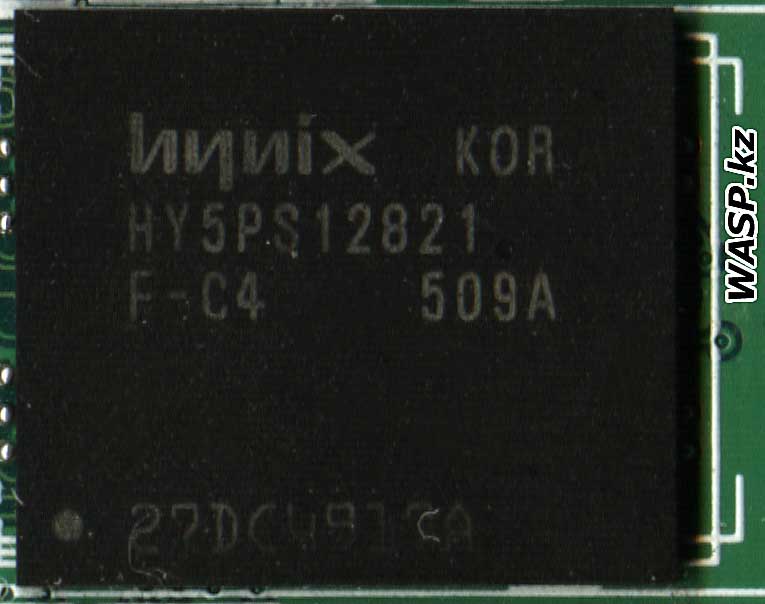
Чипы памяти производства Hynix, с маркировкой HY5PS12821F-C4. Впрочем, чипы памяти могут быть и от другого производителя - неважно!
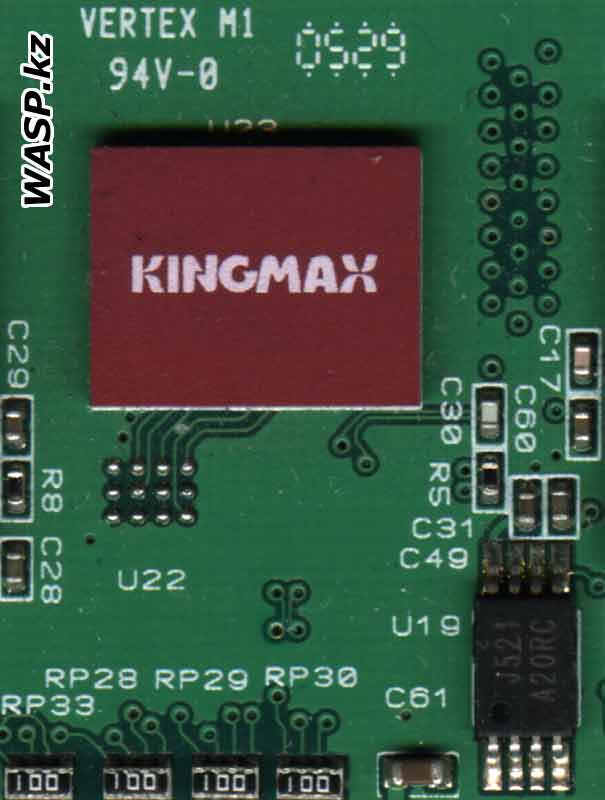
На плате распаян дополнительный чип темно красного цвета с логотипом Kingmax, так называемый ASIC - это якобы защита от подделок... Но, вероятно, это просто маркетинг... Потому что его наличие любят подчеркивать, как некий плюс, новаторскую новинку, но никто толком не может рассказать его назначение.
Информация SPD записана на другой микросхеме с маркировкой J521 A20RC.
Поверх чипов памяти наклеена этикетка ОЗУ, на ней бар код, снова логотип Kingmax, далее 512MB DDR2-533, IC:64Mbx8 HGES KLBC28K-A8HD4 и серийный номер.
Вставляем все модули памяти в материнскую плату (у меня для этого есть старенькая ECS Elitegroup 945P-A Ver:3.0), запускаем. Операционная система Windows 7.
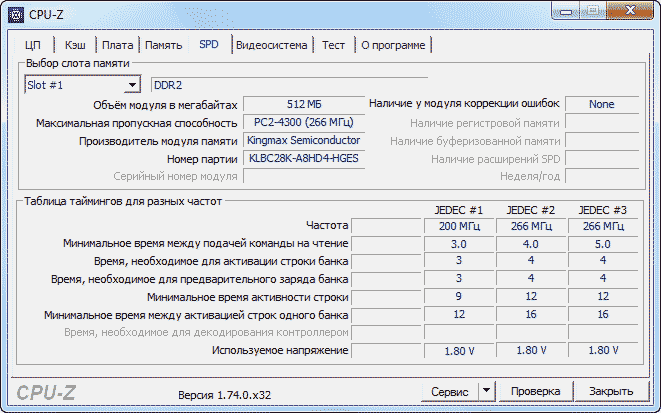
Программа CPU-Z показывает информацию SPD.
Производитель - Kingmax Semiconductor
Номер партии - KLBC28K-A8HD4-HGES
Объем модуля - 512 МБ
Максимальная пропускная способность - PC2-4300 (266 МГц)
Видим частоты и тайминги в трех профилях JEDEC - один на 200 и два на 266 МГц. Напряжение везде 1,8 вольта.
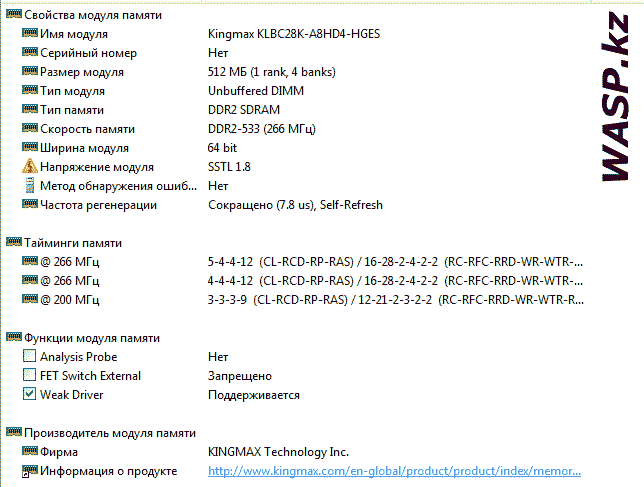
Для полноты картины запускаем программу AIDA64 и смотрим там информацию. Здесь информация совпадает с данными предыдущей программы, но здесь информации чуть больше, Это естественно небуферизированная память, поддержка Weak Driver - опция в БИОСе матплаты для повышения стабильности работы памяти, в том числе и при разгоне...
Не стану приводить результаты тестов - они самые обычные, ничем особенным не выделяющиеся, но и не хуже других. Так же я не подвергал эту память разгону - результат будет известен, а на мелкие отличия внимания обращать не стоит.
Меня заинтересовал этот дополнительный чип, так называемый ASIC - микросхема, предназначенная для решения узкоспециальной конкретной задачи. Ни одна программа наличие этого чипа не показывает, информации об нем, как я уже говорил, нет.
Со стороны можно подумать, что это просто кусочек пластмассы, приклеенный для красоты (хотя в чем здесь красота?)
Но на просвет видно, что этот чип имеет множество контактных площадок, которыми он припаян к плате... Хотя, одновременно видно, что некоторые площадки просто висят без соприкосновения - виден просвет...
Что же, берем макетный нож и поддев им этот чип, отдираем его... Он отлетает очень легко, ничего не повредив и сам не повредившись...
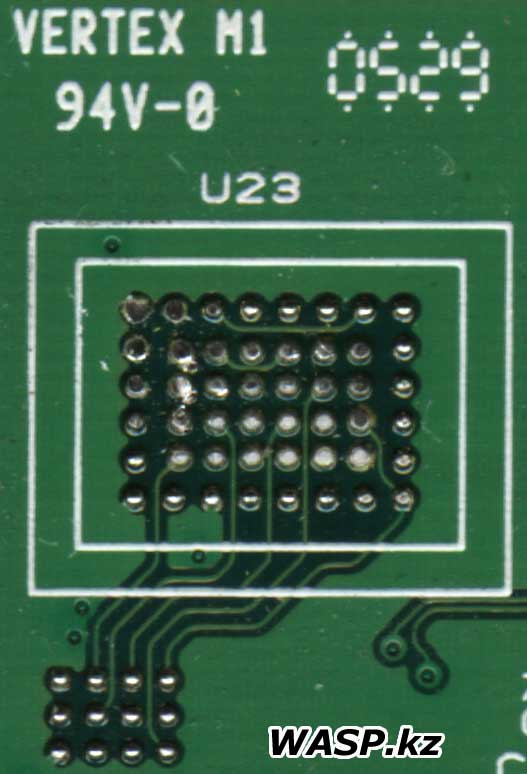
На текстолите видим нетронутые шарики олова - чип держался едва ли на пяти-шести из них...
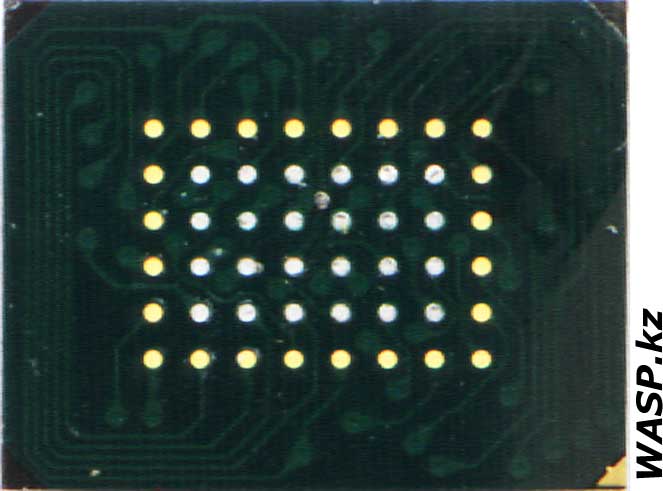
А сам этот чип действительно имеет вид чипа, те же практически нетронутые площадки под пайку... под лаком виднеются расходящиеся дорожки...
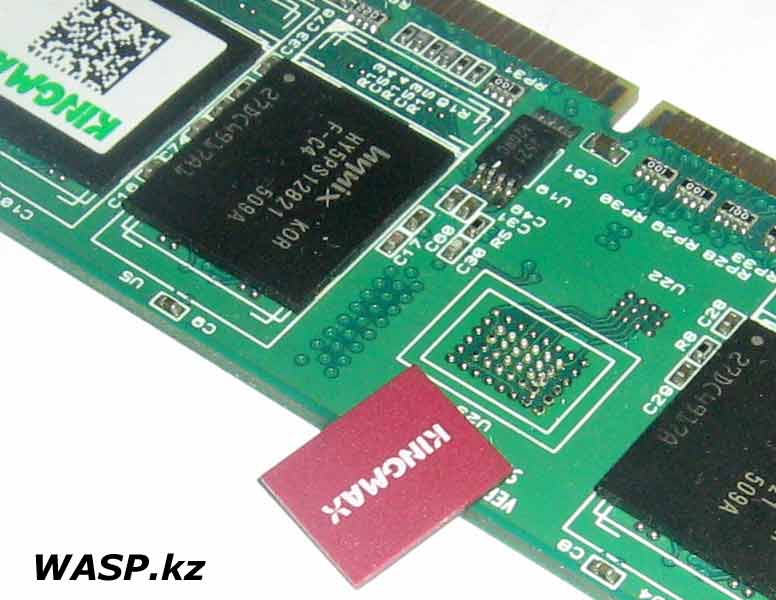
В общем - погубил я модуль памяти! Для пущей уверенности снова ставим его в материнскую плату и включаем ПК. Ага - погубил... Ничуть не бывало! Модуль памяти как работал, так и работает. Все значения в названных программах остаются прежними. Тесты проходятся с прежними результатами. Добавочные тесты никаких проблем не выявляют.
И что мы имеем в результате - обман, чип-пустышку. Копеечная стоимость, видимо приносит какие-то прибыли... Сами подумайте: одинаковая по всем параметрам память, по одной цене - какую выбрать? Но вот этот модуль с каким-то интересным дополнительным чипом, которого нет у других и который какое-то хорошее новшество... что выберет человек? Понятно, цена одна, но с чипом покупаешь КАК БЫ БОЛЬШЕ...
Данный пример откровенного лохотрона, но есть и более изощренные выдумки, особенно если дело касается "игровой" направленности. Здесь хитроумные дельцы гуляют во всю и пожинают обильные урожаи.
Михаил Дмитриенко, Алма-Ата, 2016 г.
The Kingmax KLBC28K-A8HD4 RAM is unremarkable, already outdated, although still widely used type DDR2, not the fastest - 533 MHz, and the scanty volume - 512 MB one module ... is not at all relevant. It makes no sense to describe it, however, in THIS EXAMPLE, I want to show a petty scam that some manufacturers love, and not only RAM.
So, I have four such memory modules. Each module has eight memory chips soldered on one side of the green PCB. The reverse side of the board is empty. Memory chips manufactured by Hynix, marked HY5PS12821F-C4. However, memory chips can be from another manufacturer - it doesn't matter! An additional dark red chip with the Kingmax logo is soldered on the board, the so-called ASIC is supposedly protection against counterfeiting ... But, probably, it's just marketing ... Because they like to emphasize its presence as a plus, an innovative novelty, but no one can't really tell its purpose. SPD information is recorded on another chip labeled J521 A20RC. A RAM label is glued on top of the memory chips, there is a bar code on it, again the Kingmax logo, then 512MB DDR2-533, IC: 64Mbx8 HGES KLBC28K-A8HD4 and a serial number.
We insert all the memory modules into the motherboard (I have an old ECS Elitegroup 945P-A Ver: 3.0 for this), run. Operating system Windows 7.
The CPU-Z program displays SPD information.
Manufacturer - Kingmax Semiconductor
Batch number - KLBC28K-A8HD4-HGES
Module volume - 512 MB
We see frequencies and timings in three JEDEC profiles - one at 200 and two at 266 MHz. The voltage is everywhere 1.8 volts.
For completeness, run the AIDA64 program and look at the information there. Here the information coincides with the data of the previous program, but there is a little more information here, This is naturally unbuffered memory, Weak Driver support is an option in the motherboard BIOS to increase the stability of the memory, including during overclocking ...
I will not cite the test results - they are the most common, nothing special, but no worse than others. Also, I did not overclock this memory - the result will be known, but you should not pay attention to small differences.
I was interested in this additional chip, the so-called ASIC - a microcircuit designed to solve a highly specialized specific task. No software shows the presence of this chip, there is no information about it, as I said.
From the outside, you might think that this is just a piece of plastic glued for beauty (although what is the beauty here?)
But you can see in the light that this chip has a lot of contact pads with which it is soldered to the board ... Although, at the same time, you can see that some pads simply hang without touching - you can see a gap ...
Well, we take a dummy knife and pry this chip off with it, tear it off ... It flies off very easily, without damaging anything and without being damaged itself ...
On the PCB we see intact tin balls - the chip was held on hardly five or six of them ... And this chip itself really looks like a chip, the same practically untouched pads for soldering ... under the varnish you can see diverging tracks ...
In general - I ruined the memory module! For greater confidence, we put it back into the motherboard and turn on the PC. Aha - he ruined ... Not at all! The memory module worked as it did. All values in the named programs remain the same. The tests are passed with the same results. Incremental tests show no problems.
And what we have as a result is a deception, a dummy chip. A penny cost, apparently brings some profit ... Think for yourself: the same memory in all parameters, at one price - which one to choose? But this module with some interesting additional chip, which others do not have and which is some kind of good innovation ... what will a person choose? It is clear, the price is one, but with the chip you buy AS MORE ...
This example is a frank scam, but there are more sophisticated inventions, especially when it comes to the "game" orientation. Here, cunning businessmen go for a walk and reap bountiful harvests.
Mikhail Dmitrienko, Alma-Ata, 2016